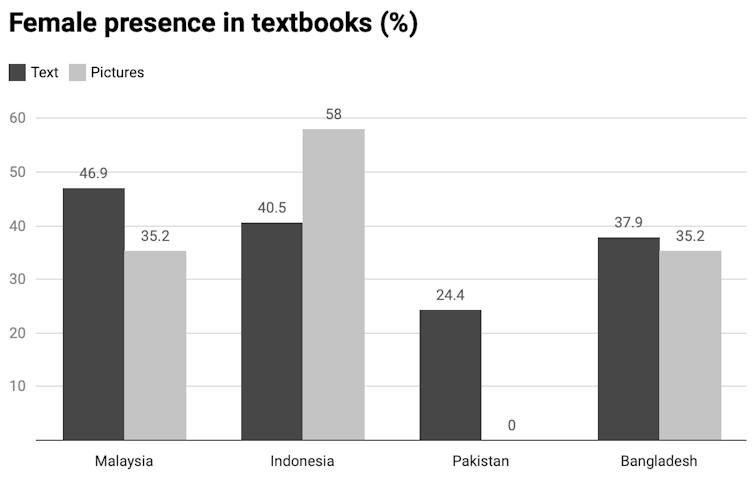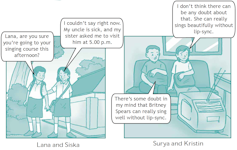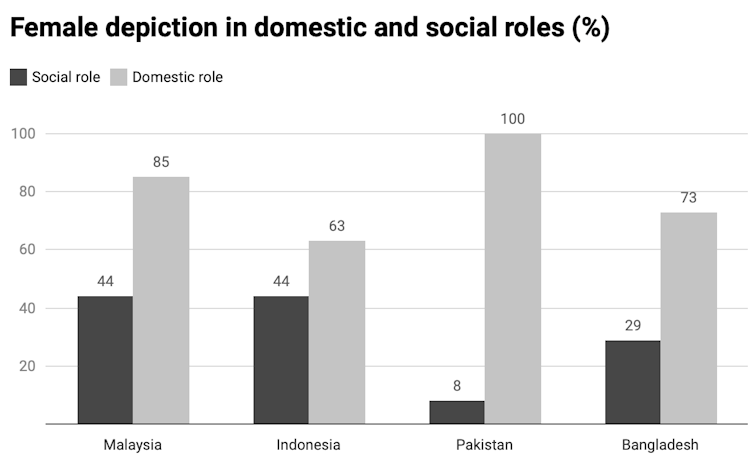Indonesia does well compared to other Muslim countries in getting girls into schools. Female enrolment in primary and secondary education is around 90% and 80% respectively, while the proportions of boys and girls in school are virtually equal.
Yet Indonesia was ranked 85 out of 153 countries in the World Economic Forum’s 2020 Gender Gap Index.
The country’s women lag behind men in terms of labour force participation. The rate of child marriage is one of the highest in South-East Asia, and a third of Indonesian women have reportedly faced sexual or physical violence.
Why does Indonesia perform poorly in women’s development in spite of the boom in female schooling?
One reason could be that the country’s education system – while accessible for all – employs teaching curriculum and learning materials that fail in challenging traditional roles and changing social attitudes towards women.
Our recently published paper in the journal PLOS ONE has found such gender bias is evident in Indonesian textbooks.
The research is part of our gender analyses of textbooks in four Muslim majority countries – Indonesia, Malaysia, Pakistan and Bangladesh.
Although the Indonesian textbook has represented gender equality better than its South Asian counterparts, especially Pakistan and Bangladesh, our analysis shows plenty of room for improvement in how female characters are depicted.
Women are present, but depicted with bias
Across these countries, we exclusively focus on government-approved English textbooks used in secondary schools.
For Indonesia, the analysis looks at the contents of the Grade 9 textbook, English in Focus.
We examine gender stereotypes using two broad frameworks – female inclusion and the quality of their representation – using a total of 21 indicators associated with the book’s texts and pictures.
Across the indicators, we find the Indonesian textbook is relatively gender equal.
The proportion of female characters in the Indonesian texts (40.5%) is fairly equal, contrasting with only 24.4% in Pakistani textbooks.

In the picture content category, Indonesian textbooks also have more female characters (58.0%) than in the other three countries. The Malaysian and Bangladeshi textbooks have a low share of 35.2%.
However, the qualitative indicators used in the study reveal that, despite having an equal presence, female characters are still poorly depicted.
A high presence of male characters is evident in a range of indicators from “Nouns” to “Professional Occupations” in the Indonesian textbook.
The book also overemphasises marital identity through the more frequent use of “Mrs” in addressing women, indicating evidence of linguistic sexism.
In contrast, most female characters in both Malaysian and Bangladeshi textbooks are referred as “Miss”.

Regarding occupational roles, the depictions of males were much more diverse and include jobs that traditionally portray power and masculinity – such as a king or a firefighter. These jobs were mentioned at least four times in the textbook.
Occupations attached to the female characters are those that have long been considered female-dominated and traditionally lower in prestige and income.
The two most mentioned professions for women are singer and dancer, with each mentioned up to three times.
Overall, across the four countries, we find females are characterised in household roles four times more than their male counterparts. The number was the highest in Pakistan, where all domestic roles depicted (100%) were assigned to women.
Even in Indonesian and Malaysian textbooks, which feature a more balanced presence of females, we found evidence that these domestic roles were dominated by women with 63% and 85%, respectively.

What does this mean for education in Indonesia?
Our study adds to the growing evidence base on gender bias in Indonesian textbooks.
In a previous study using a 12th-grade English textbook, the authors identified 1,098 (77%) male characters in comparison to only 321 (23%) female characters.
Another study of visual images used in eight English e-textbooks for grades 10, 11 and 12 confirm the problem is systemic – some professions like doctors, politicians and soldiers were represented by men only.
These portrayals of outside occupations and paid work as “male-only” devalues women’s work and hinders existing efforts and campaigns to boost the stagnant female participation rate in Indonesia’s labour force.
Improving access to secondary education will not be enough to empower Indonesian girls if school textbooks continue to misrepresent girls and women in traditional roles.
In this regard, one positive development is the Mighty Girls book collection for which hundreds of Indonesian women are serving as “reading ambassadors” to introduce strong female characters to school-going girls in Indonesia.
A free online library for children, Let’s Read, provided by the nonprofit organisation, The Asia Foundation, is available for all girls regardless of their school enrolment status. More initiatives such as these are needed.
In addition, parents must play their part as well to eliminate gender inequality from Indonesian society. Practising gender equality at home is equally important.
Reforming textbooks alone may not change mindsets if parents themselves support gender stereotypes.


